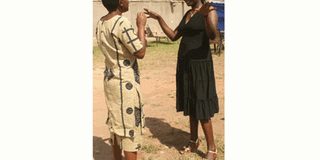Deaf in the labour ward

Aserait(R) with her interpreter who she did not have when a medical emergency arose. Photo by Stephen Otage.
It is estimated by the Uganda National Association of the Deaf (UNAD) that there are currently around 700,000 deaf people in Uganda. The population of the deaf women is still unknown. However, they are part of every society in this country and Agnes Aserait is one of them.
Aserait was overwhelmed when she found out that she was pregnant. Even though it was another chance for her to live a normal life like any woman and have children, the fear of what she would have to go through as a deaf woman bogged her down throughout the pregnancy. She had heard of stories of how deaf mothers had died or lost their babies at birth due to negligence and lack of communication with the medical attendants.
She determined to choose her hospital carefully therefore and hoped for the best. Aserait however discovered that choosing a hospital was still a challenge far ahead in the journey, when she went for her first antenatal checkup. “The first time I went to be checked and have my blood pressure tests taken, the nurse at the reception busily continued reading something and asked me without looking up at me what I wanted. I stood there motionless until she finally looked up at me, probably out of anger because I had not answered her question. I quickly used that chance to gesture to her that I was deaf,” she narrates through an interpreter.
The nurse was kind enough to use gestures to enable communication between both of them and so was the doctor. They had to communicate either in writing or using gestures. During that same visit, Aserait by lip reading found out that communication was not the only problem that she would face. The ignorance that hearing people had towards deaf people was shocking and yet not so surprising. “They believed that my husband should be ashamed of making me, “a beautiful deaf girl”, pregnant.” Aserait was once again faced with the stigma of living with her impairment, this time from the people she would entrust her unborn baby’s life and hers at delivery time.
Given the communication barrier between Aserait and the hospital stuff, she did not have the liberty of enjoying antenatal classes with a group of fellow expecting mothers; there were no provisions for interpreters during the classes. She never got to know what to expect in the future as her unborn child continued to grow inside her. If it had not been for a book from a friend, Pregnancy and Childbirth, Aserait may have never known to call the doctor when she suffered from severe stomach aches during her pregnancy. “When they checked me, the medical staff did not want to talk to me but I could tell that something was wrong although I had no way of knowing what it was.” She got a piece of paper from her bag and on it wrote asking the nearest nurse, asking her what was wrong. She wrote back and told me not to worry, but confirmed that there was something wrong with my baby,” she recounts. Not even sure if what the nurse was telling her was the true, Aserait lay there on the hospital bed helpless. For all she kn
ew, they could be telling her what she wanted to hear and not the truth. When the gynecologist told her that she had to go for a scan, Aserait was not even sure why she had to. With everything happening so fast, the paper and pen and gestures could not yield her any answers.
The scan revealed clots, which prompted an instant caesarian section to rescue her and her baby, much earlier than she had prepared for it. Her now one year and four months old baby reminds her of the angel in her friend that offered her the book and the numerous other women she has know of who have died in labour due to lack of specific attention for their special communication need.




